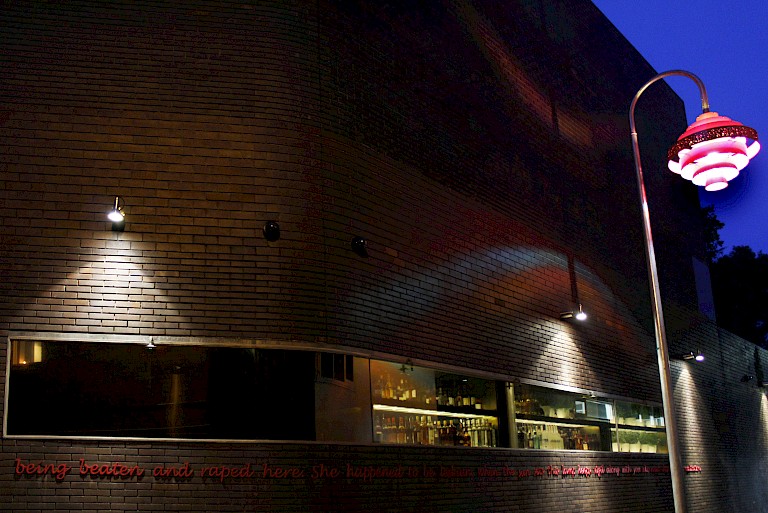



A Lamp for Mary by Sydney-based artist Mikala Dwyer was commissioned and installed in Mary’s Place in 2010. The singular and seemingly traditional street lamp is made from anodized aluminum and stands proudly in the lane. The unique lighting fixture is in the form of a red, multi-ringed and double conical shape, reminiscent perhaps of a traditional lampshade one might find in an art deco home. At night, the lamp casts a pink glow in the lane creating a meditative sense of place and remembrance, while providing adequate lighting for the safety of passersby. The artist consulted with representatives from the GLBT (Gay Lesbian Bi-Sexual and Transgender) and other community groups including Haughton Design, Wesley Mission, NSW Police Force, ACON Anti-Violence Project, St. Michael’s Anglican Church, ACON Young Lesbians Project, and Twenty10. A plaque displays a poem, written in collaboration by community representatives and poet, Michael Taussig. It reads:
“This is a lane with a name and a lamp in memory of the woman who survived being beaten and raped here. She happened to be lesbian. When the sun sets this lamp keeps vigil along with you who reads this in silent meditation.”
The reinstatement of this memorial is a testament to the growth and strength of the local GLBT community, city officials and community residents in maintaining awareness, not only of Mary’s tragedy 14 years earlier, but also of violence towards all women regardless of sexual orientation. Mikala Dwyer explains her intentions for the work: “The idea came out of nowhere and it just seemed liked the necessary thing to do as a gesture to protect, heal, warn, and also celebrate the power of survival in Mary.”
A Lamp for Mary is a hybrid artwork in the public realm that serves as a memorial and as an integrated piece of urban street furniture. It is an example of how a community consultation process, led by an artist, can be used to create an artwork that offers community representatives a sense of ownership, pride and identity of place. The functionality, site and place specific nature of the work also reflects the many roles we, as community representatives, city officials, public art administrators, and other stakeholders, have increasingly come to expect from contemporary public artwork today.
All copyright belongs to Shanghai Academy of Fine Arts, Shanghai University.


